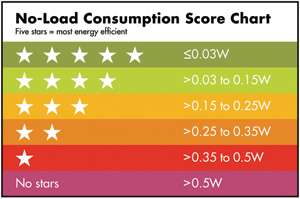By doing a simple math calculation, it's easy to understand why government agencies and mobile phone manufacturers are suddenly and actively working to reduce the standby power consumption of mobile phone chargers: more than 4 billion mobile phone users worldwide, and most of them are accustomed to even the battery completely. After you have filled and unplugged your phone, you still keep your charger connected and will continue to consume power. According to Nokia's statistics, two-thirds of the electricity used during mobile devices is consumed in no-load mode.
This article refers to the address: http://
Reducing greenhouse gas emissions and fossil fuel consumption is undoubtedly important to all of us, but in addition, mobile phone charger solutions must have tangible advantages such as reasonable cost, ease of implementation and deterministic reliability. . In this regard, Fairchild Semiconductor provides designers with ICs that leverage the company's expertise in integration and packaging to integrate a PWM controller, a MOSFET (if needed) and multiple components on a single device. Protection features that help manufacturers achieve a 5-star level of no-load power consumption of less than 30mW (only one-tenth of the industry's average power consumption of 300mW) and ±5% output CV/CC tolerance, and no secondary side Control circuit.
Strict no-load tolerance Today's mobile phone users have a wide range of requirements, including large touch screens, multi-megapixel cameras, Bluetooth and 802.11 WiFi connectivity, comprehensive web browsing, email and database access, GPS navigation, music and video downloads. And the upcoming mobile digital TV. All of these popular features require power. The phone is battery powered, and the battery can be charged from a variety of different sources, such as a cigarette lighter (power converter) on a car, a power outlet on a commercial aircraft seat, and a USB on a laptop or desktop. port.
Of course, the most common charging source is a wall-mounted AC outlet and an external AC/DC adapter, often referred to as a mobile phone charger. However, most of these devices are not true chargers. The charging circuit is actually located inside the phone.
On average, the phone only needs 2W of power when charging, and the laptop needs nearly 100W, which is why the phone charger is much smaller than the laptop charger. Despite this, with 4 billion mobile phone users worldwide and only 1 billion PC owners, reducing the standby power consumption in the user's familiar situation, that is, the no-load power consumption under the well-known conditions of engineers, has become a key design. Considerations.
The result of these concerns is a series of measures to increase efficiency and reduce the need for no-load power consumption. The latest and most stringent is a voluntary charger star rating agreement proposed by the world's top five mobile phone manufacturers to mark the energy consumption when the charger is still plugged into a wall socket after charging is completed. The star system starts from 0 stars and has a maximum of 5 stars. The charger with rated standby power consumption greater than 0.5W under no load is a 0 star tag, and the standby power consumption is less than 0.03W (30mW) for 5 stars (see Table 1). By comparison, the standby power consumption of most existing mobile phones ranges from 150 to 300 mW.
This is very important, it is necessary to reiterate that in order to get a 5-star label, the charger must reach no-load power consumption of 30mW or less (see Table 1), which is the threshold of Energy Star (level V). 90% lower.

Why Strict CV/CC Tolerance Is Important At present, batteries for small portable devices are selected for lithium ion technology. The advantages of this technology are its small size, high energy density, low self-discharge, and great flexibility in size and shape. Lithium-ion batteries are generally suitable for constant current/constant voltage (CC/CV) charging methods; the length of each charging mode depends on the capacity of the battery and the performance of the charger.
In the most basic form, when the battery voltage is low, the charger enters a constant current (CC) charging mode; at this point most of the charging energy is delivered to the battery. Once the battery is charged to a floating voltage (battery disconnected, the battery voltage is typically around 4.2V at zero current), the system will begin to reduce the charge current to maintain the desired voltage - this so-called "constant voltage" mode.
Although it is relatively simple to implement, charging the phone actually requires precise control of the floating voltage zone to maximize battery capacity and extend battery life. Inaccurate battery voltage regulation can cause the battery to be undercharged, resulting in a significant reduction in battery capacity. On the other hand, if the charging voltage is too high, the cycle life of the battery will be greatly shortened. Overcharging of a lithium-ion battery can also cause catastrophic failure of the device.
Meeting the 30mW goal For the design engineer, the threshold was suddenly pulled up. However, it may be worth recalling that more than a year ago, the situation at that time seemed to be the same as it is now. At that time, the constant voltage/constant current (CC/CV) adapter/charger designed by mobile phone power suppliers was highly praised. In standby mode, these adapters/chargers consume 75mW at 120VAC and 90mW at 240VAC, meeting the 0.5W requirements for these two input voltages in the US Environmental Protection Agency's ENERGY STAR specification.
Although 30mW is a challenging requirement, Fairchild's third-generation PSR PWM products can still be easily met. Fairchild's new FSEZ1317 device integrates a 700V power MOSFET (1A) to save space and cost. Its CV/CC tolerance is reduced from ±10% to ±5%, while the number of external resistors and capacitors has been reduced from 12 to 5 (3 resistors, 2 capacitors).
This PSR PWM controller enables very accurate CC/CV regulation without the need for sub-extreme voltage or current feedback circuitry required by other solutions. For designers, the traditional approach of using sub-extreme feedback circuits for CV/CC output regulation in battery charger applications is no longer attractive because of its high cost and high number of components, which means more Board space and a larger charger. In addition, energy efficiency is also adversely affected by the power consumption of the secondary side components.
For designs that require an external MOSFET, engineers can choose Fairchild's FAN103 PSR PWM controller. Among the many solution providers, Fairchild only offers a standalone + integrated MOSFET PWM controller option.
The key reason for Fairchild's IC products to have energy-saving performance is the use of high-voltage (HV) startup circuits, proprietary green control modes, and specially developed TRUECURRENT technology, which uses PSR-controlled flyback converters to regulate output current. No secondary feedback circuit is required. The controller uses analog signal processing and sampling techniques to regulate the output voltage/current through the primary winding of the transformer. With this approach, the charger can achieve a smaller form factor, lower standby power consumption, and higher efficiency than traditional circuit designs.
Vehicle-mounted Led Display Screen is a equipment displaying text,picture,cartoon and video,which is powered by dedicated power supply.The displaying function is achieved by the bright extinction of the metrix LED module to which the controlling card receiving and transmittes data.LED vihicle display screen is always intalled on Taxi,City Bus,Police wagon,which comes out along with the rapid development in Led Display industry.LED vehicle display screen need high level grade on stabilization,anti-interference,anti-vibration and dust-proof.Besides offering complete and best solutions,Shenzhen Cxcolor Optoelectronic Company limited is a professional manufacturer specialized in LED display screen,LED stage rental display screen,Led Advertising Display screen,small pitch LED display screen,LED transparent display screen,vehicle LED display screen,LED spherical display screen,LED energy-saving display screen.

Mobile Truck Led Display,Mobile Led Screen Trailer,Mobile Led Display,Mobile Truck Largest Led Display
Shenzhen Cxcolor Optoelectronics Co., LTD. , http://www.largeledscreen.com